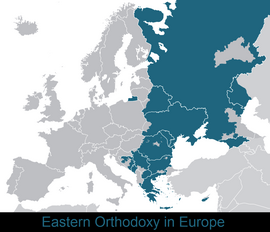Eastern Orthodoxy in Europe Christian demonation on the continent
Eastern Orthodoxy in Europe[image reference needed Serbian Orthodox Monastery of Gračanica The Eastern Orthodoxy in Europe constitutes the second largest Christian denomination. European Eastern Orthodox Christians are predominantly present in Eastern and Southeastern Europe , and they are also significantly represented in diaspora throughout the Continent. The term Eastern Orthodox Europe is informally used to describe the predominantly Eastern Orthodox countries of Belarus , Bulgaria , Cyprus , Georgia , Greece , Moldova , Montenegro , North Macedonia , Romania , Russia , Serbia and Ukraine .
History
This section
needs expansion . You can help by
adding to it .
(May 2023 )
Almost all of Eastern Orthodox Europe became part of communist states after World War II , either through direct annexation by the USSR or indirect Soviet dominance through satellite states .[ 1]
Eastern Orthodoxy in Orthodox majority countries
Eastern Orthodoxy in Moldova , 97.0% (2017 census)[ 2] Eastern Orthodoxy in Greece , 90%[ 2] Eastern Orthodoxy in Serbia , 84.6% (2011 census)[ 3] Eastern Orthodoxy in Georgia , 83.4% (2014 census)[ 4] Eastern Orthodoxy in Romania , 81.0% (2015 census)[ 5] Eastern Orthodoxy in Russia , 79% (est. )[ 2] Eastern Orthodoxy in Bulgaria , 77% (2011 census)[ 6] Eastern Orthodoxy in Cyprus , 73.2% (est. )[ 7] Eastern Orthodoxy in Belarus , 73% (2011 census)[ 8] Eastern Orthodoxy in Montenegro , 72.1% (2011 census)[ 9] Eastern Orthodoxy in North Macedonia , 69.6% (est. )[ 10] Eastern Orthodoxy in Ukraine , 67.3% (est. )[ 11]
Eastern Orthodoxy in non-Orthodox majority countries
Eastern Orthodoxy in Bosnia and Herzegovina , 31.0% (2013 census)[ 12] Eastern Orthodoxy in Albania , 20% (est. )[citation needed Eastern Orthodoxy in Latvia , 19.4% (2011 census)[ 13] Eastern Orthodoxy in Estonia , 16.15% (2011 census)[ 14] Eastern Orthodoxy in Austria , 8.8% (2018 census)[ 15] Eastern Orthodoxy in Lithuania , 4.9% (2011 census)[ 16] Eastern Orthodoxy in Croatia , 4.44% (2011 census)[citation needed Eastern Orthodoxy in Italy , 3.5% [citation needed Eastern Orthodoxy in Germany , 2.4%[ 17] Eastern Orthodoxy in Slovenia , 2.3% (2002 census)[citation needed Eastern Orthodoxy in Spain , 2.2% (by Wikipedia)Eastern Orthodoxy in Poland , 1.5% (by Wikipedia)[citation needed Eastern Orthodoxy in the Republic of Ireland , 1.3% (2017)[citation needed Eastern Orthodoxy in Finland , 1.09% (2020 census)[ 18] Eastern Orthodoxy in Slovakia , 0.9% (2011 census)[ 19] Eastern Orthodoxy in Norway , 0.22% (2012)[citation needed Eastern Orthodoxy in Armenia , 0.2% (2022 census)[ 20] Eastern Orthodoxy in Hungary , 0.1% (2011 census)[ 21]
See also
References
^ Mary B. Cunningham; Elizabeth Theokritoff (18 December 2008). The Cambridge Companion to Orthodox Christian Theology ISBN 978-0-521-86484-8 ^ a b c "Religious Belief and National Belonging in Central and Eastern Europe" . Pew Research Center. 10 May 2017. Retrieved 2017-09-09 .^ "2011 Census of Population, Households and Dwellings in the Republic of Serbia" (PDF) . Statistical Office of the Republic of Serbia.^ "საქართველოს მოსახლეობის საყოველთაო აღწერის საბოლოო შედეგები" (PDF) . National Statistics Office of Georgia. 28 April 2016. Archived from the original (PDF) on 5 February 2017. Retrieved 29 April 2016 .^ "Culte recunoscute oficial în România" . Secretariatul de Stat pentru Culte (in Romanian). Archived from the original on 2016-08-14.^ "NSI" . Archived from the original on 28 January 2012. Retrieved 24 February 2012 .^ Pew Research Center's Religion & Public Life Project: Cyprus . Pew Research Center . 2010.^ Religion and denominations in the Republic of Belarus by the Commissioner on Religions and Nationalities of the Republic of Belarus from November 2011 ^ "Census of Population, Households and Dwellings in Montenegro 2011" (PDF) . Monstat . pp. 14, 15. Retrieved July 12, 2011 .^ "Strategies of symbolic nation-building in West Balkan states: intents and results (completed) - Department of Literature, Area Studies and European Languages" . www.hf.uio.no . Retrieved 2018-01-19 .^ Особливості Релігійного І Церковно-Релігійного Самовизначення Українських Громадян: Тенденції 2010-2018 Features of Religious and Church - Religious Self-Determination of Ukrainian Citizens: Trends 2010-2018 ] (PDF) (in Ukrainian), Kyiv: Razumkov Center in collaboration with the All-Ukrainian Council of Churches, 22 April 2018, pp. 12, 13, 16, 31, archived (PDF) from the original on 2018-04-26^ "Bosnia and Herzegovina" . United States Department of State . Retrieved 2022-10-23 .^ "Tieslietu ministrijā iesniegtie reliģisko organizāciju pārskati par darbību 2011. gadā" (in Latvian). Archived from the original on 2012-11-26. Retrieved 2012-07-25 .^ "Statistical database: Population Census 2000 – Religious affiliation" . Statistics Estonia . 22 October 2002. Archived from the original on 15 May 2011. Retrieved 2011-02-18 .^ "In Österreich leben mehr Orthodoxe als Muslime" . 13 September 2018. Retrieved 7 November 2018 .^ Department of Statistics to the Government of the Republic of Lithuania. "Ethnicity, mother tongue and religion" . Archived from the original on 2014-10-08.
^ Gesellschaft Orthodoxe Medien e.V. im Auftrag der Orthodoxen Bischofskonferenz in Deutschland (Hrsg.): Orthodoxer Liturgischer Kalender 2017. , 18. Jahrgang, 2016, S. III: In Deutschland können wir begründeten Hochrechnungen [zufolge] inzwischen von einer Zahl von bald an die zwei Millionen orthodoxer Christen ausgehen, die immer mehr in die hiesige Gesellschaft hineinwachsen und sich in ihr verwurzeln.
^ "Belonging to a religious community by age and sex, 2000-2020" . Tilastokeskuksen PX-Web tietokannat . Government. Archived from the original on 2 April 2019. Retrieved 5 April 2021 .^ "Table 14 Population by religion" (PDF) . Statistical Office of the SR. 2011. Archived from the original (PDF) on November 14, 2012. Retrieved Jun 8, 2012 .^ Republic of Armenia Census (Report). Statistical Committee - Republic of Armenia. 2022. Table 5.5.^ "1.26 Population by religion and sex, 1930–1949, 2001" . Hungarian Central Statistical Office . Archived from the original on 11 May 2011. Retrieved 21 November 2008 .
Sources
Sovereign states States with limited


